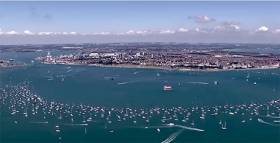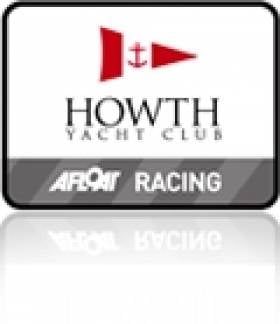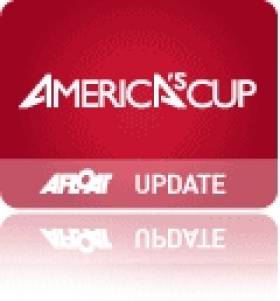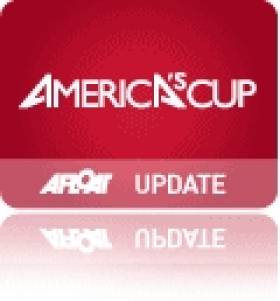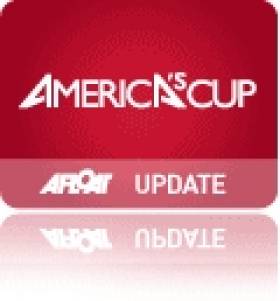Displaying items by tag: Ben Ainslie
It's the direct link between Sir Ben Ainslie and the boat built to bring the America's Cup home; the steering wheel that Ainslie will be holding as he strives to drive Land Rover BAR's America's Cup Class boat to success this summer in Bermuda. And the wheel is a direct result of a long partnership with the team's title and exclusive innovation partner, Land Rover. This remarkable piece of technology has been in development for the past 18 months within the Technical Innovation Group (TIG), chaired by the management and technology consultancy PA Consulting Group, and is now being revealed ahead of the start of racing on 26th May.
The control of an America's Cup Class foiling multihull is a two-dimensional problem. The wheel doesn't just turn the boat left and right as it would do on a conventional boat, but it also controls the boat's height and attitude above the water, through control of the power delivered from the hydrofoils.
The hydrofoil does what it says on the tin – hydro-foil – a foil in water. Just like the aerofoil – the wings that lift planes into the air – the hydrofoils deliver lift, in this case, they push the boat up and out of the water.
So the steering wheel must allow Ainslie to both steer the boat, and control the hydrofoils so he can 'fly' the boat fast and smooth above the water. It's a bit like tapping your head and rubbing your tummy. There are two sets of controls to keep the boat on the right track both horizontally and vertically; left and right, up and down. The left and right part was straight-forward, that's what the steering wheel does. It was the up and down that needed creativity, innovation and cool technology.
The Human Machine Interface (or HMI) is an area in which Jaguar Land Rover (JLR) have considerable experience, technical expertise and a reputation for innovation in their cars – as anyone who has driven the latest Discovery will know. No one with an interest in safety wants to take their eyes off the road for any longer than they absolutely have to, and good HMI can allow you to complete a task without looking, with the minimum of mental effort.
Ben Ainslie required exactly the same of the hydrofoil control on the wheel of the ACC boat. There were many possible ways it could be done; from switches to dials, gear shifts to twist grips. Some could be quickly discarded, others were tried, developed, prototyped for testing and simulation. The best of the ideas went forward with working prototypes built that could be tested on the boat. Of these, there was a clear winner – the paddle shift.
The analogy with the paddle gear shift on a performance car is a good one. The hydrofoil needs to be adjusted in steps as the boat accelerates and decelerates, just as you would change gears in a car as you accelerate or decelerate. Go faster, tap towards you; go slower, tap away from you, each shift attuned to the demand for the optimum performance of the boat, just as a car driver seeks to match the gear to the speed and engine revs for maximum efficiency
Win For Ainslie's Team BAR in Portsmouth
Super Sunday in Portsmouth, double points on offer, excellent flying conditions on the water and thousands of fans thronging on the shoreline. Ben Ainslie’s Land Rover BAR was at the top of the first day leader board and got royal support for the start of day two, with the Duke and Duchess of Cambridge, getting a close up look from the support boat. After the three races it's a win for for the home team and a double celebration as they went to the top of the series lead overall. See video below.
Ainslie Leads in Front of Portsmouth Home Crowd
There were perfect conditions for the thousands of fans who came out to watch the Louis Vuitton America's Cup World Series action close in to shore at Portsmouth yesterday.
Land Rover BAR led in front of their home crowd. See video below.
Sir Ben Ainslie's New America's Cup Yacht
The first images of Sir Ben Ainslie's new racing yacht have come in, and the British racer is calling the boat the most advanced he's ever had.
The British design team who built the Land Rover Ben Ainslie Racing AC45 T2 craft have likened it to a fighter jet, citing use of cutting edge technologies from both the automotive and aerospace industries.
At 45 feet, Ainslie's T2 boat is a prototype design for the America's Cup team whose final build, yet to come, is expected to reach speeds in excess of 50 mph.
The British America's Cup Challenger is Launched in Portsmouth
The British America's Cup challenger, Land Rover BAR, has launched its latest testing boat – T2 – at their home in Portsmouth. This boat will increase the momentum already developed with the initial launch of 'T1' last October. It's the next stage in the relentless pursuit of technological excellence that will culminate in the design and build of the final race boat to challenge for the America's Cup in 2017.
T2 is designed to drive forward a new era of British maritime design and technology. The boat uses the latest technology from both the aerospace and automotive industries to create the marine equivalent of a fighter jet. T2 will fly on foils the size of a wakeboard, whilst lifting the weight of a fully occupied London taxi
Famous Half–Tonner Checkmate Gets New Berth At Howth Yacht Club
#checkmateforhowth – The story is that there has been a bit of re-juggling in the Half Tonner lineup at Howth, where Dave Cullen has moved on from the historic King One which once upon a time took the Half–Ton World Cup for the legendary Paul Elvstrom of Denmark, whose Olympic gold medal scoreline is bested only by Ben Ainslie.
The good news is that King One is going to continue to sail the waters of fair Fingal. She now has a Rush-based owner, who plans to continue to keep her at Howth where they've a handy little group of classic Half Tonners sharpening up for 2015.
And a further welcome word is that Dave Cullen himself will be returning to the fray, having taken over Nigel Biggs' all-conquering Half Tonner Checkmate. This little honey has had so much TLC and classy mods made in recent years that 'tis said a statement had to be issued saying the boat is NOT called Cheque Mate...........
Ben Ainslie's Team Take to The Waters of The 35th America's Cup
#benainslie – Ben Ainslie Racing were the first America's Cup team both on – and under – the race course waters of the 35th America's Cup last week, when the team conducted an initial training camp in Bermuda.
"It's been great for the team to get out on the water, trying to learn about the venue, the wind direction, the wave states in our 20 foot foiling training boats," commented Team Principal and Skipper, Ben Ainslie. "A huge amount has been learnt, and we can now go back to our design team and start working on developing the final race boat for 2017."
"We turned up here with preconceived ideas about everything," added Sailing Manager, Jono Macbeth. "But it's not until you actually step foot on the island that you get a feel for what's going on. It's going to be completely different compared to last Cup where the wind direction was the same every single day. Here we have seen wind from just about every corner.
"We're just learning all the time. It's invaluable that we are here, especially as the first team on this race course. It's a statement that we are serious about the competition ahead of us. The atmosphere here in anticipation of the America's Cup is incredible," continued Macbeth, "Everyone on the island is so into it. This year is just going to fly by."
"Bermuda is just the most beautiful island," said Ben, "the people are so warm and friendly and are really excited about having the America's Cup here. As a sailing venue it is a real challenge, it is such a tight course and the wind is really variable out here in the middle of the Atlantic."
The major objective of the training camp was to learn the local conditions, and raise foiling skills, but Ben Williams, Head of Strength and Conditioning ensured that the Sailing Team got an extensive work out as well.
"It's been great for us as a sailing team to get away," said Ben. "It's almost been a military operation, our fitness trainer is an ex-Marine and pushing us pretty hard in the morning and evenings. And out on the water we have been sailing and training very hard – but bonding as a team, being away and really focusing on sailing and training."
"I really wanted to make sure that we were using our time wisely out there so we are doing two training sessions in the gym and sailing the boats five or six hours every day," said Macbeth. "There's really not a huge amount of time for the boys to do anything except eat, train and go sailing." Williams unique methods included an opportunity to properly test the depths of Bermudian waters
The America's Cup World Series Portsmouth Receives Royal Support
#americascup – HRH Princess Anne, The Princess Royal, visited the America's Cup World Series Portsmouth (ACWS Portsmouth) display at the London Boat Show, to support Ben Ainslie Racing and the America's Cup World Series events planned between 23 – 26 July 2015.
The ACWS Portsmouth events will be managed and delivered by 'TEAMORIGIN Events', a company set up and chaired by Sir Keith Mills, the man central to the delivery of some of the UK's greatest sporting events, most recently as Deputy Chairman of London 2012 and Chairman of 'Invictus Games'.
During HRH Princess Anne's visit, Sir Keith Mills outlined details of the Portsmouth event:
"The ACWS Portsmouth will be a spectacular event for Britain. One of our main aims is to provide a sporting event that will benefit Portsmouth by bringing huge visitor numbers into the city to experience the racing. To bring in the masses, we have to provide cost effective entertainment for all budgets and we have been working hard to firm up the event schedule and ticketing structure."
Mills continued, "Portsmouth will become a hive of activity with its key locations such as the Spinnaker Tower and Historic Dockyard incorporated within the event to showcase the city in all its glory. The event officially starts on Thursday 23rd July with the teams taking part in a F1 style paddock day. All ACWS teams will set up their boats in a publicly visible area inside the Historic Dockyard and Royal Navy Base. This is a fascinating visible process and a fantastic opportunity to see the amazing race boats, teams and sailors close-up. Friday 24th July, is the official race training day and the first opportunity for the teams to test their skills on Portsmouth waters. Saturday 25th and Sunday 26th July is when the points scoring action begins with the official race days. Both days will count and be vitally important for the teams in their quest for glory in the 35th America's Cup. This will be a unique opportunity for the British public, Portsmouth is truly opening its doors to local and visiting public and all sporting fans."
Sir Ben Ainslie, HRH The Princess Royal and Sir Keith Mills at the London Boat Show
A key ethos for the ACWS Portsmouth team is bringing the action closer to the fans. This includes a full entertainment programme which will run throughout the event days alongside live broadcasting of the racing. For those that really want to come and immerse themselves in the sailing and racing action and everything that goes on in the world of America's Cup, there will be a dedicated and ticketed 'fan zone' and a world class 'hospitality pavilion' where visitors, sponsors and guests can get truly involved and watch the racing close up with live expert commentary.
During the London Boat Show, ACWS Portsmouth Event Director, Leslie Greenhalgh outlined the ticketing, hospitality and commercial plans:
"The best possible viewing and engagement experience will be watching the racing from the 'race village' on Southsea Common and the dedicated 'fan zone' and 'hospitality pavilion'. This is all about "America's Cup racing coming to shore". There will be giant screens, live commentary and the racing will be literally metres off the Common. Racing will take place in the main shipping channel in an area of water carefully managed by the Queen's Harbour Master. For safety and traffic management reasons, there will be a tightly controlled exclusion zone around the race course and so we will be designating various levels of 'spectator boat' zones. The spectator boat packages, access flags and options will be published alongside the land based ticket and hospitality options. We urge any visitors not commit to any packages that are not endorsed by TEAMORIGIN/ACWS Portsmouth. All details and tickets will go live in February 2015."
Greenhalgh added: "An event of this magnitude offers numerous opportunities for brands and businesses to become commercially involved and we are currently in discussion with a number of partners interested in the event sponsorship and supplier partnerships. This is an amazing opportunity for UK brands and businesses to associate their brand with this exciting event. We urge attracted parties to get into touch with our commercial team."
Sir Keith Mills and Sir Ben Ainslie at the London Boat Show
Rob Andrews, the London 2012 Sailing Venue Manager, has taken on the role of Race Director for the ACWS Portsmouth and will work alongside the America's Cup Event Authority to deliver the racing. Rob provided a preview of the exciting racing coming to Portsmouth:
"The first difference people will notice, since the last ACWS events, is that the AC45 boats will now be foiling – literally flying above the water. The vulnerability of the foils makes margins between getting it right and wrong on the race course very small. This means numerous position changes during racing which creates lots of excitement. My role is to deliver good, solid races for the sailors whilst also giving the viewing public action-packed entertainment 50-100 meters from the shore. We learned a lot from the London 2012 Olympic Sailing medal races and how close we could get the racing to people on shore without being detrimental to the standard of racing for the sailors. The Portsmouth course and proximity of the race village on Southsea Common is the perfect solution for this type of racing and we cannot wait to deliver it to the fans and spectators. Whether you are a sailing fan or just coming down to join in the festival atmosphere and to take a look at these boats, it will be exciting and you do not want to miss it."
Over 500,000 visitors are expected to visit Portsmouth during the event and TEAMORIGIN are looking to secure volunteers to ensure they deliver a tremendous experience for all involved. The Event Volunteer Engagement Programme will be launched in February 2015. TEAMORIGIN will be looking to engage around 60 people in 'on water' delivery and a further 300 volunteers to ensure local people get involved and help to deliver this spectacular event. Anyone who would like to express interest in volunteering can email: [email protected]
The count down to the 2015 ACWS Portsmouth (23-26 July 2015) has begun. For more information: visit www.teamorigin.com
#bar – The Ben Ainslie Racing (BAR) team says Britain's sailing superstar is leading the sporting world in sustainability, in its bid to bring the 35th America's Cup to the UK.
The sailing team, formed by Olympic multi-gold medallist Ben Ainslie, is announcing a long-term partnership with renewables investor Low Carbon. The partnership will provide the team with clean energy as it develops its 2017 bid for the world's oldest international sporting trophy.
Low Carbon will ensure the team's headquarters – currently under construction on the Camber in Portsmouth – is powered by the very latest, high efficiency solar photovoltaic (PV) technology. The initial target is to supply 90% of the team's electricity power needs, with this improving to 100% once energy monitoring is implemented.
Low Carbon is committed to mitigating climate change by encouraging, wherever possible, the reduction of carbon emissions. Investing capital into renewable energy, the firm's investment model embraces solar PV, concentrated solar power, wind and bio-waste technologies. Within less than four years, Low Carbon has developed more than 270MW of UK solar power. A broader international portfolio exceeding 2GW is in the pipeline.
The partnership will greatly support BAR's efforts to run a sustainable business with clean energy. It will also see the team's HQ accorded BREEAM 'Excellent' status – the hallmark of excellence in sustainable building. The BAR HQ is expected to be completed in the summer of 2015.
Commenting on the partnership, Low Carbon's Founder and Chief Executive Roy Bedlow said: "I'm very excited by this long-term partnership, and with the prospect of making a key contribution to a true British success story. With Low Carbon and BAR sharing an ethos of sustainability, responsibility and mitigating the effects of climate change, I believe that together we can continue to make a difference for the better, long into the future."
BAR's Team Principal, four-time Olympic medallist and America's Cup winner, Ben Ainslie commented, "We're delighted to be onboard with Low Carbon, and this new partnership takes us a long way towards our goal of sustainable, clean energy for our new base."
Bedlow adds: "This project has exciting implications for renewable energy. Because the BAR philosophy is about educating and engaging locally, the project will be a fantastic showcase for how large buildings can be almost entirely sustainable."
In a separate initiative, Roy Bedlow is joining the board of the team's charity as a Trustee. Launched in October 2014, the 1851 Trust seeks to inspire and engage a new generation through sailing and the marine industry, providing young people with the education, skills and training required to become innovators of the future, and stewards of the marine environment.
Giles Scott Joins Ben Ainslie Racing, Eighth Sailor to Join British America's Cup Team
#bar – Anyone who followed the build-up to the 2012 Olympic Games will remember that the biggest hurdle to Ben Ainslie's historic fourth gold medal was another Brit by the name of Giles Scott.
Their rivalry was one of the most compelling stories of the lead-up to the London 2012 Olympics – a classic narrative as Scott, the apprentice and former training partner, attempted to unseat the dominant figure of the previous generation, and win the single Team GBR place at the Games.
History records that Ainslie won selection, and then won his fourth gold medal. But Giles Scott used his time wisely; he raced with Luna Rossa in their 2013 America's Cup campaign, and this summer won the Finn Olympic Class World Championship in Santander. Scott is now a firm favourite for gold in Rio 2016, and will be a key member of the British America's Cup team, Ben Ainslie Racing.
Their story began much earlier than most people realise, right back when Scott was a talented junior.
"The first time I met him was years and years ago," recalled Scott when he came in to the BAR offices to sign his contract. "I was doing a National Junior event. I was with the Northampton team, and Ben came and did a talk. I think I would have been about ten years old, sailing with my older brother. I didn't talk to him, but I think I got a sweater signed by him!"
"We crossed paths at various events after that," he went on, "but it was when I started sailing the Finn (the Olympic class boat in which Ainslie won his final three gold medals) that I really got to know him. It was 2006 when he came back to the boat – after two years away – to prepare for the 2008 Games. I was one of the youngest members of the Finn squad and still at University, and Ben was the figurehead."
Ainslie remembers that time clearly. "It was a lot of fun because they were talented guys who were enjoying learning to sail a new class of boat, and for me it was refreshing having some young, motivated guys there to train with – so it worked very well. And Giles was the stand-out talent of that group." Scott was the ISAF Youth World Champion in the single-handed class in 2005. "They didn't really have any expectations of the 2008 Olympics," added Ainslie, "but then with me moving away into the America's Cup, it was a different story when I came back in 2010. They were that much older, and really going for the 2012 Games."
Thanks to the idiosyncrasies of the Olympic rules, only one person per nation can compete in each of the ten sailing events. Ben Ainslie and Giles Scott were — by any reasonable measure — the best two athletes in their class in the world. Scott was World Champion in 2011; while Ainslie was World Champion (for the sixth time) in 2012. But because they were both British, only one of them could go to the Games.
"The thing is about Giles," said Ainslie, "he's a really nice guy, and I remember saying to him in the build-up to 2008 that it's great to be nice, but you also have to learn to stand-up for yourself and not let people push you around. Of course, he'd really taken that to heart and so it was a slightly different story for 2012 when he was going for the Olympics. And quite rightly, he needed to stand up for himself. He had just as much right as anybody else to that spot."
"There was a switch in my mentality," said Scott. "I had to switch from having Ben on a pedestal, to seeing him as a competitor that I wanted to beat. There was no switch in the way that we operated off the water, but on the water there was a definite transition. He was always trying to assert the dominance that he had always had, and I was constantly trying to break that down."
The two men went head-to-head in the events that Team GBR had defined for the selection process. "I won a lot of the events in the build-up to the start of the selection events," reflected Scott, "and then [when it came to the selections] Ben was at the top of his game and he ticked all the boxes, while I finished second." The rest is history, Ainslie got the spot on the British team, went to the London Olympics and, under almost unimaginable pressure, won his fourth gold.
"The one good thing that came out of it was that it opened up the America's Cup doorway," commented Scott. He started sailing with Team Korea, and then Luna Rossa offered him a place on their sailing team.
"All the guys you speak to at Luna Rossa only have good things to say about Giles and how he fitted in with the team," said Ainslie. "And that's one of the reasons why we wanted him to be part of this team. There are a handful of sailors of his generation in the world that stand out as really a cut above the rest, and Giles is clearly one of those. We have been very selective about the people that we have brought in; we know that they will gel with the team. And with Giles, it was a 'no-brainer'. A good team player and a winner. We are very excited about him being with us."
Scott has continued where Ainslie left off, and now dominates the single-handed men's Finn class, recently winning the 2014 World Championships with clear blue water between him and the pack. It's obvious that Scott has unfinished business with that Finn gold medal, and doesn't intend to let it slip away again.
Combining America's Cup sailing with the Olympics is something that Ainslie knows all about, but how does Scott think he will fare? "I'm hoping it will be easy to integrate the two, and achieve my Olympic goals and have a positive impact on the Cup. It's an amazing project to be involved in. I'm just feeling very excited about getting my teeth into it and trying to make it all happen."
Stephen 'Sparky' Parks, RYA Olympic Manager, agrees joining BAR is a positive move for Scott, "Joining BAR is a great option for Giles. No one understands what it takes to win an Olympic medal better than Ben Ainslie – and that will help to ensure that Giles gets the job done in Rio before focussing exclusively on the America's Cup. Giles will be able to draw on Ben's experience to ensure he keeps the Finn Olympic Gold medal in GBR hands, where it has been since 2000. Equally, Ben knows Giles well, and he knows he will bring a host of raw sailing skills to the BAR programme."
And what about working with Ben after all those bruising encounters on the water? "It's very useful to have been through that, because if two people were ever going to fall out over something, it would be over an Olympic selection – you are battling each other for your dream. Going forward from that, I have a knowledge of him and how he performs – what he likes, what he doesn't like – you just know each other, so I think it can only be a positive thing," concluded Scott.
Giles Scott – Fact file
Date of Birth: 23rd June 1987
Place of Birth: Huntingdon
Current Home: Weymouth
Major Titles: ISAF Youth World Champion 2005; Finn World Champion 2011 and 2014; Finn European Champion 2011 and 2014; Rio Olympic Test Event 2014.




























